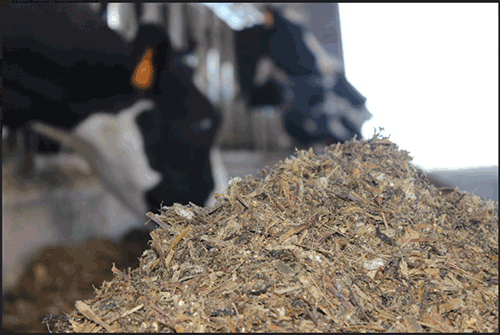
The first 60 days of the lactation are critical to maximize milk production potential.

The transition period, 21 days before through 21 days after calving, is a challenging time for the dairy cow. Changes in pens, hormones, metabolism, rations and weather add stress, increasing a cow's energy requirements. At the same time, her feed intake may be compromised particularly in the five days before freshening.
 "Understanding the challenges faced by recently fresh cows is essential to moving the needle on your herd's milk production potential," says Dr. Stu Rymph, dairy nutritionist with Purina Animal Nutrition. "The rule of thumb is for every additional pound of peak milk per cow, a herd can see an additional 200-250 pounds more milk per cow over the entire lactation. As a result, fresh cows set the pace for the entire herd's milk production performance and the first 60 days post-calving define a cow's lactation."
"Understanding the challenges faced by recently fresh cows is essential to moving the needle on your herd's milk production potential," says Dr. Stu Rymph, dairy nutritionist with Purina Animal Nutrition. "The rule of thumb is for every additional pound of peak milk per cow, a herd can see an additional 200-250 pounds more milk per cow over the entire lactation. As a result, fresh cows set the pace for the entire herd's milk production performance and the first 60 days post-calving define a cow's lactation."A cow will not milk more than her genetic potential. "We can however remove many obstacles and allow her to get as close to that genetic potential as possible," says Dr. Rymph. "Consider that the cow has the potential to go from 0-140 pounds of peak milk in less than 60 days and from 28-60 pounds of dry matter intake in less than 70 days if there are no obstacles."
To make these changes, the cow needs to be prepared prior to freshening, in addition to receiving the right mix of energy and protein/amino acids after freshening.
"Approaches like controlled energy rations, high-straw rations and DCAD balancing to minimize metabolic issues at freshening are important strategies, but they are only half of the equation," says Dr. Rymph. "Did you prepare the rumen environment for the rapid increase in feed consumption or prepare the liver to efficiently process mobilized tissue reserves post-freshening? The cow's entire system must be ready to go if they are to ramp-up feed intake and milk production in less than 70 days.
Once the cow freshens, evaluate the feeds that are put in front of her. "We often err on the side of caution and tame-down the pre-fresh ration to keep her on-feed. That's fine, but with a little more attention, we can find a balance of digestible and indigestible fiber, starch, sugars, fat and protein sources to keep her on feed and peak higher without excessive weight loss."
For a herd to hit its production goals, the fresh cow program must be a priority. Reducing the number of metabolic issues shouldn't be the only concern, it also about utilizing technology to meet increased energy demands and to drive production for fresh cows.
At only $15 per hundredweight of milk, that 1 pound difference in peak milk can potentially mean $30.00-$37.50 more income per cow per lactation. Even at today's milk prices, investing $0.18 more per cow per day from 3-weeks pre-fresh through 60 days post-fresh holds potential to double the return with a single additional pound of milk at peak.
"Don't throw money at the cows, but rather strategically spend for the potential for greater returns," adds Dr. Rymph.
Redefine success on your operation and ask the question, how much milk are you leaving on the table with your current transition cow strategy?
For more information, contact Dr. Stuart Rymph by email: sjrymph@landolakes.com or go to: www.dairyfeedtechnology.com.
For additional information on dairy nutrition and management, sign-up to receive the monthly Purina®HERDSMART® E-Newsletter; a free online tool to improve operational efficiency by visiting: www.bit.ly/ManagementTips.
 Purina Animal Nutrition LLC (www.purinamills.com) is a national organization serving producers, animal owners and their families through more than 4,700 local cooperatives, independent dealers and other large retailers throughout the United States. Driven by an uncompromising commitment to animal excellence, Purina Animal Nutrition is an industry-leading innovator offering a valued portfolio of complete feeds, supplements, premixes, ingredients and specialty technologies for the livestock and lifestyle animal markets. Headquartered in Shoreview, Minn., Purina Animal Nutrition LLC is a wholly owned subsidiary of Land O'Lakes, Inc.
Purina Animal Nutrition LLC (www.purinamills.com) is a national organization serving producers, animal owners and their families through more than 4,700 local cooperatives, independent dealers and other large retailers throughout the United States. Driven by an uncompromising commitment to animal excellence, Purina Animal Nutrition is an industry-leading innovator offering a valued portfolio of complete feeds, supplements, premixes, ingredients and specialty technologies for the livestock and lifestyle animal markets. Headquartered in Shoreview, Minn., Purina Animal Nutrition LLC is a wholly owned subsidiary of Land O'Lakes, Inc.Because of factors outside of Purina Animal Nutrition LLC's control, individual results to be obtained, including but not limited to: financial performance, animal condition, health or performance cannot be predicted or guaranteed by Purina Animal Nutrition LLC.
1.30.2015